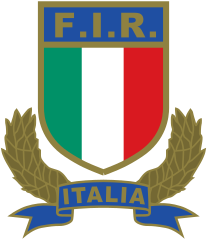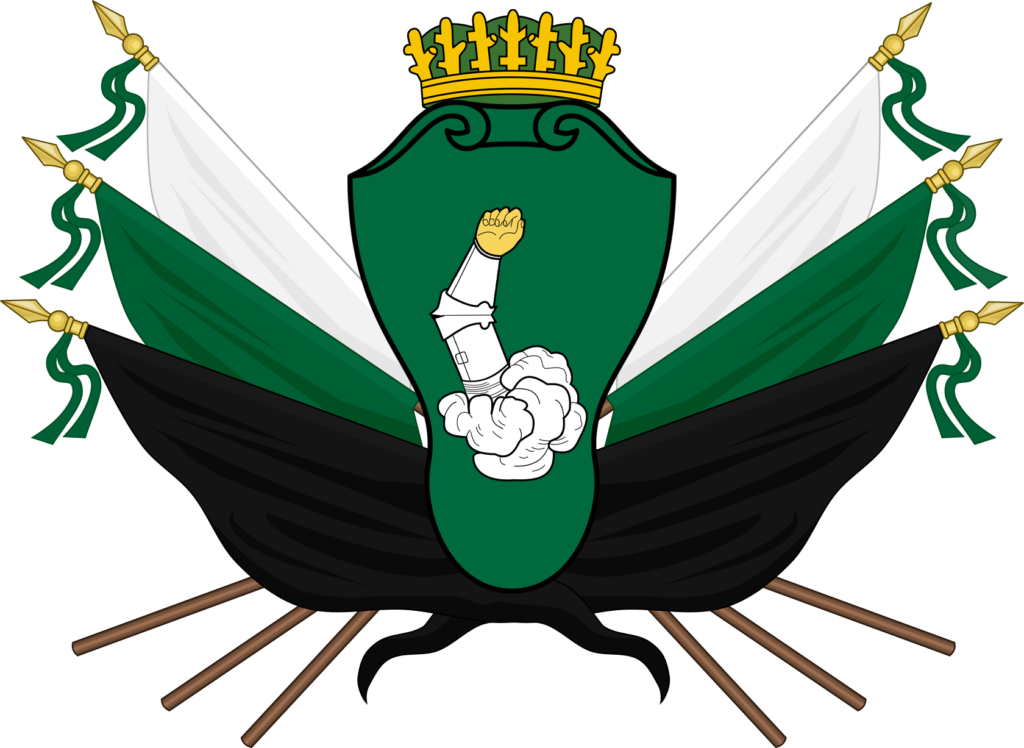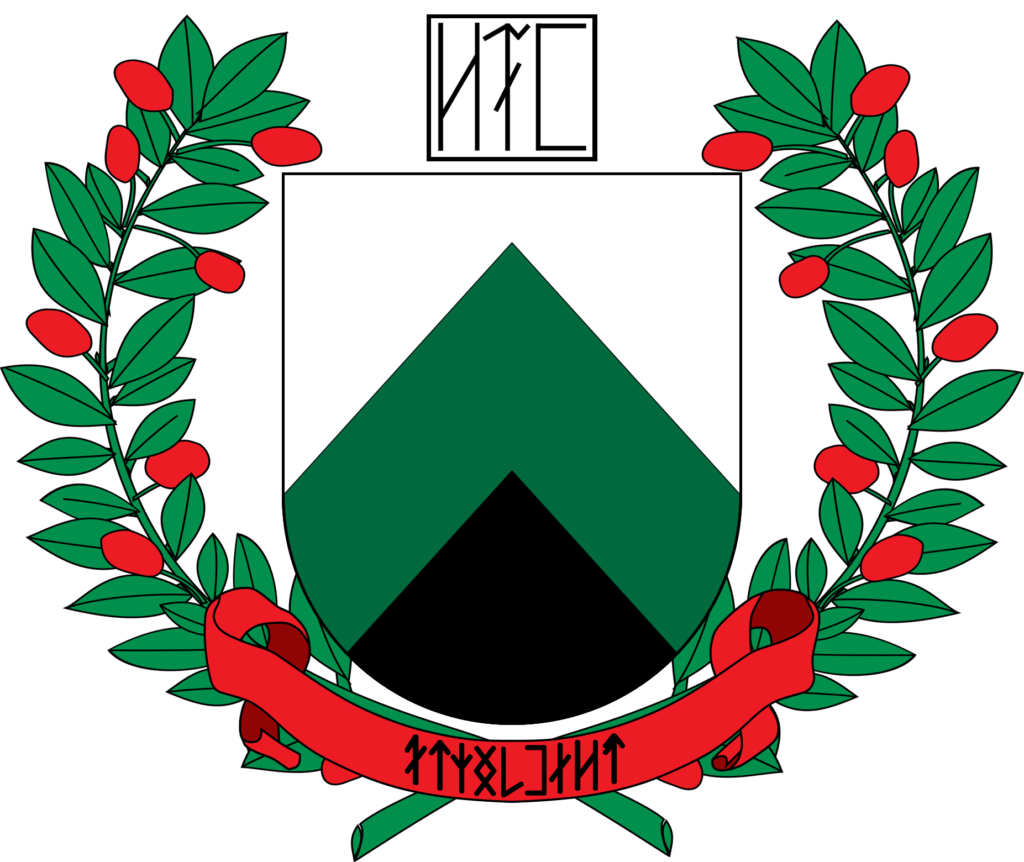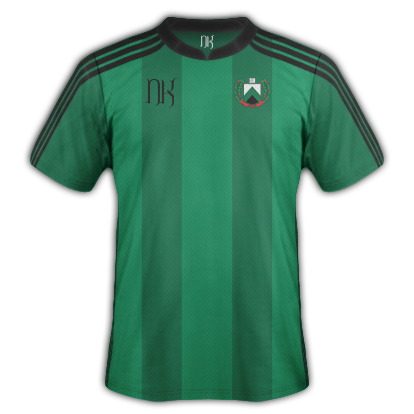Today I went on a bit of a winding road of world building and it all started because I wanted to make a soccer kit. Over-all the kit took about ten minutes to make and the world building took about four or five hours by my count. It involved conlanging, linguistics, some alphabet work, image manipulation, heraldry, and then eventually some soccer.
Let’s get a baseline.
Anyone who follows my profile on Wikipedia (if you do, wow, that’s uh… dedication…) will see that I often just “doodle” soccer kits there using the Wikimedia template for kits. In the last week I added six more:
These are meant to represent home and away kits for three nations from the world of my novels sped up to the “present” day (about 450 years after my novels). Why? Because it’s fun for me. The top two are Hadyrland, the country most of my novels are set in; the middle two the Union, which is heavily involved; and Steriou, which a couple characters have ties to.
Note: yes, the three shades of orange in the bottom two bothers the FUCK out of me.
The national sport of Hadyrland is Kémõ /keɪmɔ̃/ (Hurling) and the national sport of the Union is (in Hadysh) Wixgaħ /wɪxgaʁ/ (Cricket). I have these words because they are in my novels. I’ve even posted about Hadysh Hurling in the past.
But like in this world, just about every nation plays football, which is also the national sport of Steriou. And also like in our world, there is a big international organization that regulates the sport and organizes the world game between all the nations.
I wanted to make a realistic rendering of the Hadysh home kit, so that meant I needed certain details, like a crest. The crest would need some details too: shapes, colors, labels, elements. So for that I started with the crest of the Italian National Rugby team (they played today, so it was on the mind). It’s a simple tricolor crest with the initials of the national rugby federation on top and the name of the country at the bottom. Plus a little wreath.
So that’s where I started. Hadyrland’s modern flag is also a tricolor, though with horizontal bands of white, green, and black. This physically represents the nation, with its frozen north, forested center, and mountainous south. But to give this a bit of dynamism, instead of using three horizontal bands, I used a peaked design.
The Hadysh national coat of arms shows the white-green-black motif:
For the wreath I went with something that had berries. The Yew Tree is the national symbol of the nation, as well as being an important religious symbol for the majority of its citizens. So I found a vector of a wreath with berries and moved forward.
I got a banner and then things started going down hill…
So if you look at the Italian crest you see FIR – for the Federation of Italian Rugby (Federazione Italiana Rugby) and at the bottom a simple Italia, which I think most people can get without a translation. Well, I know the Hadysh name for Hadyrland: Volgamfyə /vɔlgamfjə/, but I am missing the “FIR” element. So I started working.
I started with the name “Hadysh Football Federation” and then reordered it into proper Hadysh (while still using English): “Federation Hadysh Football”. “Federation” is the subject, “Hadysh” is an adjective, and “Football” would need to be a genitive noun.
Then I open up my Hadysh dictionary. Which words do I have? Hadysh. That’s it. The adjective form is b̌olgē /bvɔlgi/.
So I have some work to do making up new words. Federation was easiest because it could be a concrete idea. In German the word for federation is Bund. This comes from the same root as “bind” in English, as in “bound together”, which a federation is – units bound together to make a whole. For “federation” I went with a simple word, like German: ya̋f /jaʊf/.
Two down, now “football”. Well, I can break that down into two units: “foot” and “ball” and then recombine them, which in Hadysh would be “ballfoot” with the foot being in the genitive.
Ooooookay…. for “foot” I went with bod /bɔd/, which is a reference to “pode” the Greek for foot. And for ball? ð̌aç /dðaç/. Little bit more work… the genitive for bod is bot (the genitive is usually word + (e)d, but if it ends with d it devoices to t). So the Hadysh for “football” is ð̌açbot /dðaçbɔt/.
But… but… we can take this further. So, oftentimes, words get adopted into a language from another language. “Football” is one of these words that often end up in other languages because it is easier to just adopt a new word then something up. For a bit of fun I decided that in Hadysh ð̌açbot would be the actual piece of equipment, while the word for the sport would come from Union Common, which is a distant relative to Hadysh. I don’t actually have two conlangs going so we needed to de-evolve the words ð̌aç and bot back to the last shared ancestor of Common and Hadysh and then re-evolve it forward to present-day Common.
Common is more like English in how it compounds words so in Common it would be foot + ball instead of ball + foot, so I decided it was best to do the two components separately and then recombine them.
I actually have a chart showing the genetic relationships between Hadysh and some of the other languages back to a language called “Proto Piylo-Tundric” which is the mother of many of the northern languages on the continent Sun-King and others take place on. Whole branches of these languages are extinct so I need to go up six steps and then down five.
Now, not every step is distinct, but it helped think about how the languages worked and this whole thing would come in handy later. Also, the question, why not Sterian for the language if that’s where the sport is most ubiquitous? Common is more of a prestige language and while the Union is not nearly as big as it once was, there are far more Common-speaking nations than Sterian or Hadysh combined.
So, “ball”…
Hadysh to Old Hadysh: /dðaç/ ➝ /ðʲaç/. The decision here was that consonants at the start of stressed syllables underwent sound changes akin to Gaelic/Russian where they could be palatalized before open vowels, unchanged before mid vowels, and labialized before close vowels. /a/ is back, so /ð/ becomes /ðʲ/. The implication here is that as Old Hadysh turned into Middle and then Modern Hadysh, this palatalized phoneme became it’s own sound /dð/ unrelated to /ð/.
Speeding up: /ðʲaç/ ➝ /dʲæç/ ➝ /ˈdʲæk.əl/ ➝ /dəˈkʲʌl/ gets us as far back as it needs to go, back to Old Piylean. Now it needs to move forward through time:
/dəˈkʲʌl/ ➝ /dəˈkʌl/ ➝ /dᵊˈkʌl/ ➝ /gʌl/ ➝ /gɔl/
And “foot” from Hadysh to Old Piylean:
/bɔd/ ➝ /bʲɔd/ ➝ /bʲɑd/ ➝ /bʲɑt/
And now from Old Piylean to Modern Common:
/bʲɑt/ ➝ /pɑt/ ➝ /pat/ ➝ /paθ/
You’ll notice that the word for “foot” has been significantly more conservative than the word for “ball”. This is because a foot is more significant to ancient peoples than a ball. So the word is preserved better. When you look at the ancient word for “ball”, it had two syllables. As it moves toward the present it drops to one with the Hadysh branch keeping the first syllable /də/ (which in its first step away from Old Piylean becomes stressed to /dʲæ/) and the Common branch keeping the stressed /kʲʌl/. The words /dðaç/ and /gɔl/ have nothing in common, but are related none the less.
So the Common word for “football” is /ˈpaθ.gɔl/.
So now I can come up with the acronym for the Hadysh Football Federation: YB̌P for Ya̋f B̌olgē Paþgold.
I will remind you, this entire exercise was for one of those three letters.
So now I can finish… making…
Fuck, Hadysh doesn’t use the Latin alphabet except when I write on the internet. In the fantasy world it would use it’s native alphabet. Luckily I have that alphabet, I just don’t have it digitized. So hang on.
There YB̌P at the top and Volgamfyə at the bottom. The crest is done.
Now I can put together that soccer kit.
There, that wasn’t so hard, was it?
That said, the longest parts were the image manipulations. Even though the linguistics takes up the lion’s share here, I played around with the vectors and the images far longer than I spent making up words. There was also a lot of background stuff with the linguistics, like filling in my dictionary with the new words and their declinations, which is important only to me.
Now will I make a crest for their dreaded rivals, the Sunrays out of Rannot?
Probably not.
No.
Cheers, everyone.





